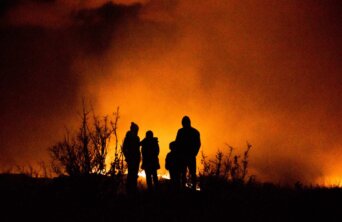- About
- Topics
- Picks
- Audio
- Story
- In-Depth
- Opinion
- News
- Donate
-
Signup for our newsletterOur Editors' Best Picks.Send
Read, Debate: Engage.
| topic: | Global Warming |
|---|---|
| located: | Canada |
| editor: | Karan Anand |
The residents of Calgary, the biggest city in the Canadian province of Alberta, woke up last week with a thick orange smoke blanketing the sky. Right away, Environment and Climate change Canada issued a warning, listing the air quality index as “very high risk.” Since then, thousands of residents have complained about breathing difficulties, especially after spending a few hours outside their homes.
The orange smoke covering Calgary was a result of the early onset to the wildfire season in Alberta and other parts of western Canada. Experts cite hot and dry weather conditions as the trigger behind this intense and early start to the forest fire season. As of Tuesday, 74 fires were burning in Alberta, with 20 of them labelled “out of control.”
This year’s wildfires have already burnt more than one million hectares of forests in Alberta, forcing more than 24,000 people to leave their homes. Compared to the 900,000 hectares of forest that burned down in 2019, this year’s rate threatens to cause unprecedented damage.
“We’re getting warmer, so we’re seeing more fire,” explained Professor Mike Flannagan of Thompson Rivers University in British Columbia. Dry fodder after the spring thaw, combined with hot weather, acts as fuel for the fires and severely increases their intensity.
This hot and dry weather has resulted in the most powerful events of forest fires in Canadian history, all within the last decade. In fact, the area burned by forest fires annually has more than doubled since the 1970’s.
Canada’s federal government has recognised the menace caused by wildfires and pledged $346 million to train over 1,000 firefighters and provide latest equipment to the provinces to prevent forest fires. However, experts believe that wildfires in Canada have become so intense in the last decade that merely trying to suppress and fight them is not enough.
Professor Flannagan has suggested that, at times, it is necessary to let the fires burn and run their course instead of trying to put them out.
Similar measures have been suggested by scientists around the world. Phuntsho Namgyel, a Bhutanese forest scientist, has advocated for a forest thinning programme. Forests which are “overstocked” with trees are more susceptible to intense fires and hence, sometimes it is beneficial to allow small, controlled burns to reduce the impact of intense forest fires.
Others have suggested a partial or complete ban on the presence of humans in forests during the wildfire season. It is believed that many wildfires in Canada are human-induced and a ban on human presence in forests for a few months could prevent part of the issue.
It is not just the health and environmental hazards associated with wildfires that has worried Canadians. Forest fires also bring with them severe economic costs.
Data released by the federal government revealed that Canadian fire management agencies have spent somewhere between $800 million and $1.4 billion every year over the last decade. This investment has been crucial in a bid to protect Canadians, critical infrastructure, businesses, private residences and wood supply.
The wildfires also have the potential to impact the Canadian GDP, as economists from the Bank of Nova Scotia have predicted that the fires could shave off as much as 0.2-0.3 percent from the country's revenues. Alberta, which is an important oil-producing province, has seen production decline steeply in the wake of these latest wildfires.
The human and economic cost of Canadian wildfires is too big to be ignored. The recent wildfires in Alberta, which are the second biggest in Canadian history in terms of area burned, have once again shown that the federal government needs to do more to prevent their spark in the first place.
Image by Caleb Cook

